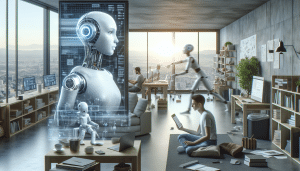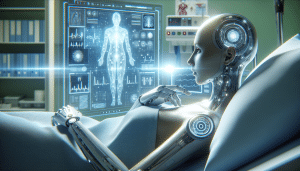AI Tools You Might Not Know Are Shaping Daily Life
Oliver Cooper September 25, 2025
Artificial intelligence quietly powers many moments of daily life. This article explores practical uses, touchpoints where AI helps behind the scenes, and how these evolving tools keep making an impact in homes, businesses, and society in ways few notice.
AI’s Hidden Influence in Everyday Technology
Artificial intelligence is often discussed as a buzzword, but its true presence lingers in devices and services we interact with every day. From the voice assistant that sets reminders to the navigation system suggesting the quickest route, AI-powered systems work quietly in the background. Even social media feeds that appear custom-tailored use algorithms deeply embedded in artificial intelligence. The understated way AI influences these technologies is remarkable. Without spotlight or fanfare, it optimizes services, filters content, and even predicts user needs. These mechanisms are deeply woven into the fabric of everyday technology, making complex decisions appear simple and natural.
Most people encounter AI multiple times before lunchtime without realizing it. Think about streaming music. Services recommend tracks based on advanced AI analysis of likes, past plays, or even mood, creating playlists that feel uniquely personal. When searching online for information or shopping for goods, AI engines sort and reorder results to anticipate what one would likely find relevant. Today’s technology relies less on rigid coding and more on learning patterns and adapting, thanks to the machine learning backbone that AI provides. Each subtle adjustment, like improved spam filters or personalized ads, is an evolution of AI-driven decision making.
Many businesses now leverage AI to predict demand, manage inventory, or provide responsive customer support. Automated chatbots on websites are prime examples, using natural language processing to interpret queries and offer rapid assistance. These AI-driven systems reduce wait times and streamline problem-solving, improving experiences without the user ever realizing the underlying complexity. This seamless integration is shaping not only how companies operate but also how individuals manage their routines, from schedule optimization to improved security on personal devices.
Personal Assistants and Smart Devices Beyond the Hype
Digital companions like Alexa, Google Assistant, and Siri have moved far beyond simple question-answering gadgets. Today, their neural network-powered engines understand language nuances, execute context-aware tasks, and even learn personal habits to offer tailored reminders or suggestions. The AI in these assistants is not static. It evolves, adapting to accents, favorite routines, and unique speech patterns, which dramatically enhances usability. They control lights, thermostats, and even grocery ordering—all through subtle, instant AI-powered interpretation and action.
Home automation doesn’t stop at the assistant. Smart surveillance cameras now distinguish between pets, people, and package deliveries, instantly notifying homeowners of relevant movement only. AI-powered tools within security systems can analyze audio and video in real time, making quick, contextually relevant decisions. From regulating home energy use to enhancing entertainment setups, these intelligent devices transform mundane environments into dynamic, adaptive ecosystems. The backbone of this change lies in machine learning systems quietly working under the surface.
For those concerned about accessibility, AI makes a significant difference as well. Voice-activated technology, powered by advanced natural language processing, bridges barriers for users with visual or physical limitations. Tasks that once required fine motor skills—like typing or manually adjusting home devices—are now handled by intelligent assistants. These innovations create more inclusive environments and demonstrate that practical AI can support independence for everyone.
Healthcare Transformations Driven by AI
AI breakthroughs extend far beyond convenience—they’re powering a revolution in health. From smartphone apps that track sleep quality to sophisticated systems analyzing diagnostic scans, machine intelligence is redefining personal well-being. Technologies now exist to analyze heart rate, blood oxygen, and even stress levels in real time, with algorithms that identify subtle health trends invisible to human eyes. Routine checkups are enhanced as clinicians get decision support from AI, leading to faster identification of risks and more customized care plans.
In hospitals, AI-driven tools help streamline everything from patient intake to advanced imaging. AI can read radiology scans—like X-rays and MRIs—scanning for conditions such as early-stage cancers with a high degree of accuracy. By highlighting areas of concern, artificial intelligence can reduce diagnostic delay, assist with triage, and sometimes catch patterns missed by traditional methods. With electronic health records, AI also predicts complications or medication interactions, supporting more informed clinician decisions.
AI is even finding its way into mental health. Chatbots and therapy apps provide support outside of standard office hours, analyzing sentiment through text or voice and suggesting wellness activities. These platforms use natural language processing to “listen” empathetically and connect the dots, offering relief and resources to those who might not otherwise seek help. Such integration of AI into daily wellness routines is giving people more control and flexibility in caring for their health.
AI and Personalized Learning Experiences
Education has undergone significant shifts, with AI-enabled tools providing new ways for learners to interact with material. Adaptive learning platforms assess strengths and weaknesses in real time, serving up exercises or hints depending on performance. This creates a learning environment that feels personal, keeping engagement high. AI goes further by powering intelligent tutoring systems and grading essays, allowing educators to focus more on guidance and less on repetitive assessment tasks.
Students benefit not just academically, but also through practical skills. Language learning apps, for example, adjust difficulty based on how quickly new vocabulary is absorbed, while AI-driven sign language interpreters make educational content more accessible. Even standardized test prep harnesses machine learning models to identify commonly missed questions or recommend focus areas, improving success rates and learner confidence. The possibilities for customized instruction are vast as machine intelligence matures.
Beyond children and college students, adult learners also find value in AI tools. Career development platforms suggest courses based on job market demand, current skills, and individual interests. By analyzing workforce trends, these AI systems provide tips on which certifications or skills may be most valuable. The result is a bridge between evolving career needs and lifelong learning—made possible, in large part, by the structured guidance AI delivers.
AI and Privacy: What Users Should Understand
While AI makes daily life easier, it also raises critical questions about personal data and privacy. AI systems learn from vast datasets, often collecting voice, movement, or behavior data to improve accuracy. This reliance on ongoing data presents important considerations about consent and how personal information is safeguarded. Transparent privacy settings and clear opt-in policies are central topics for both users and developers as AI’s footprint grows.
Major tech companies and governments have responded by developing comprehensive guidelines around responsible AI use. These address how and when data can be stored, shared, or used in the training of machine learning models. Industry standards encourage the minimization of personally identifiable information and support secure data storage. Still, ongoing vigilance is necessary as new applications arise. AI’s rapid evolution means privacy frameworks must be flexible and responsive.
Ultimately, understanding how AI-driven personalization works helps users make informed choices. Most platforms provide privacy dashboards where users can review or delete their data. Real control comes through clear policies, user education, and transparency from providers. As artificial intelligence continues to expand into finance, transportation, and even dating apps, keeping data protection a priority remains as important as the innovations themselves.
The Future of Everyday Life with AI Tools
The horizon of artificial intelligence in daily living keeps expanding. Developers are working on systems that anticipate household needs—like AI that schedules appliance maintenance or suggests nutritional adjustments based on dietary patterns. In urban planning, AI already helps manage energy grids, traffic flow, and emergency response, driving forward smarter, more adaptive communities. Tomorrow’s smart homes and cities will depend on artificial intelligence not just to automate but to truly orchestrate our environments.
Expect advances in collaborative AI, where multiple intelligent systems work together, from home to workplace and beyond. Imagine a daybook that schedules meetings, a car that optimizes routes, and a refrigerator that orders healthy food, all coordinated seamlessly. These improvements rely on robust connectivity, further integrations, and ethical frameworks that ensure benefits are shared widely. The line between convenience and complexity will continue shifting thanks to evolving AI solutions.
While challenges remain—from bias reduction to clear accountability—AI offers a powerful toolkit for shaping healthier, smarter, and more equitable societies. Staying curious and informed empowers individuals to make the most of what’s available and to voice expectations for new applications. Each small change signals a bigger shift: artificial intelligence, once visionary, is now an everyday companion quietly improving life from the background.
References
1. U.S. Department of Energy. (n.d.). Artificial Intelligence at the Edge. Retrieved from https://www.energy.gov/artificial-intelligence
2. National Institutes of Health. (n.d.). Artificial Intelligence in Healthcare. Retrieved from https://www.nih.gov/research-training/medical-research-initiatives/ai-healthcare
3. EdTech Magazine. (n.d.). Adaptive Learning: Data-Driven Instruction Meets Individualized Learning. Retrieved from https://edtechmagazine.com/k12/article/2022/08/adaptive-learning-data-driven-instruction-meets-individualized-learning
4. Pew Research Center. (n.d.). Artificial Intelligence and the Future of Humans. Retrieved from https://www.pewresearch.org/internet/2021/06/21/artificial-intelligence-and-the-future-of-humans
5. World Health Organization. (n.d.). Ethics and Governance of Artificial Intelligence for Health. Retrieved from https://www.who.int/publications/i/item/9789240029200
6. European Commission. (n.d.). Ethics guidelines for trustworthy AI. Retrieved from https://digital-strategy.ec.europa.eu/en/library/ethics-guidelines-trustworthy-ai







